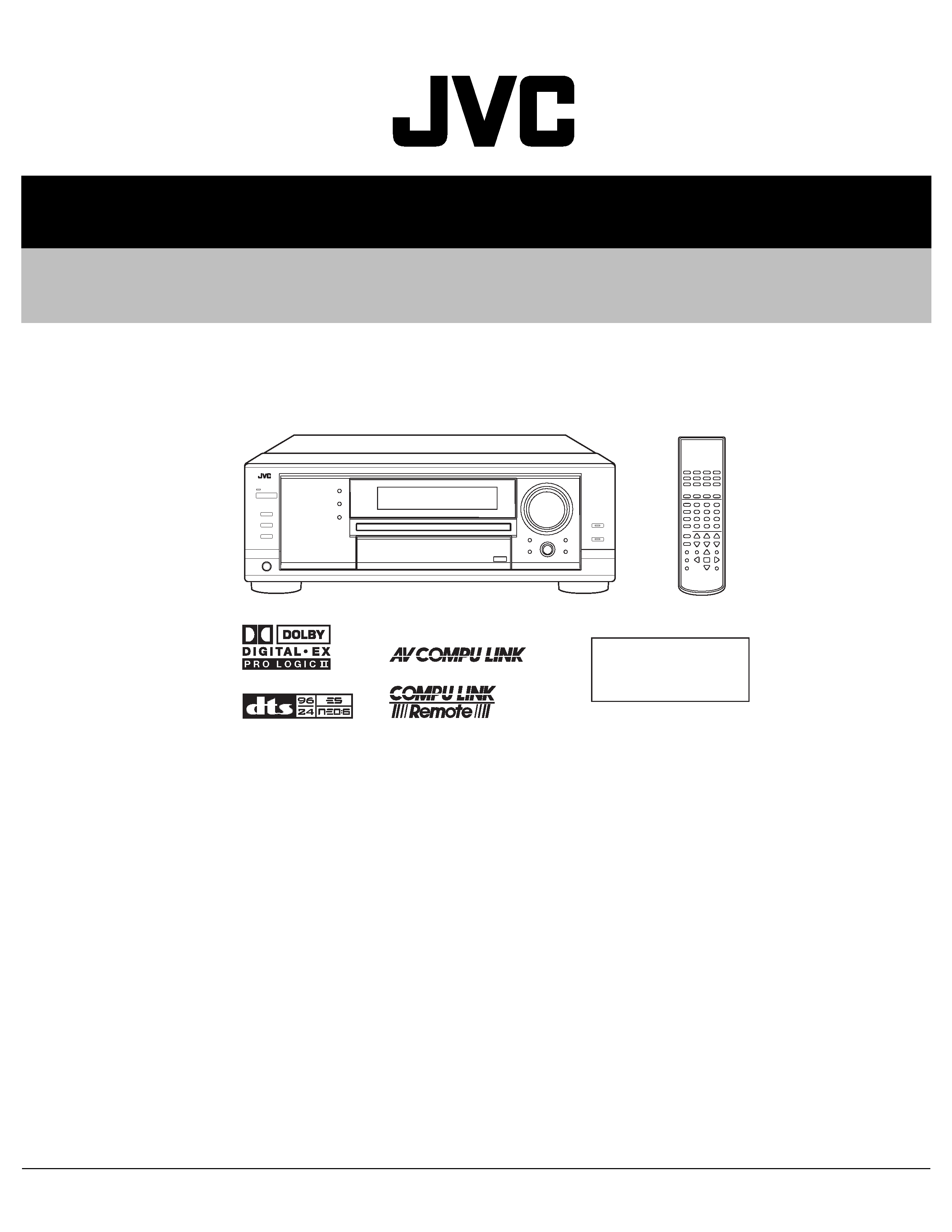
SERVICE MANUAL
COPYRIGHT © 2003 VICTOR COMPANY OF JAPAN, LTD.
No.22058
2003/5
AUDIO /VIDEO CONTROL RECEIVER
22058
2003
5
RX-7030VBK
TABLE OF CONTENTS
1
Precautions . . . . . . . . . . . . . . . . . . . . . . . . . . . . . . . . . . . . . . . . . . . . . . . . . . . . . . . . . . . . . . . . . . . . . . . . . . . . 1-3
2
Disassembly method . . . . . . . . . . . . . . . . . . . . . . . . . . . . . . . . . . . . . . . . . . . . . . . . . . . . . . . . . . . . . . . . . . . .1- 4
3
Adjustment. . . . . . . . . . . . . . . . . . . . . . . . . . . . . . . . . . . . . . . . . . . . . . . . . . . . . . . . . . . . . . . . . . . . . . . . . . . . 1-12
4
Description of major ICs . . . . . . . . . . . . . . . . . . . . . . . . . . . . . . . . . . . . . . . . . . . . . . . . . . . . . . . . . . . . . . . . . 1-14
23
1
56
4
89
7/P
0
+10
MENU
ENTER
CONTROL
A/V CONTROL RECEIVER
10/0
Area Suffix
J ------------------ U.S.A.
C --------------- Canada
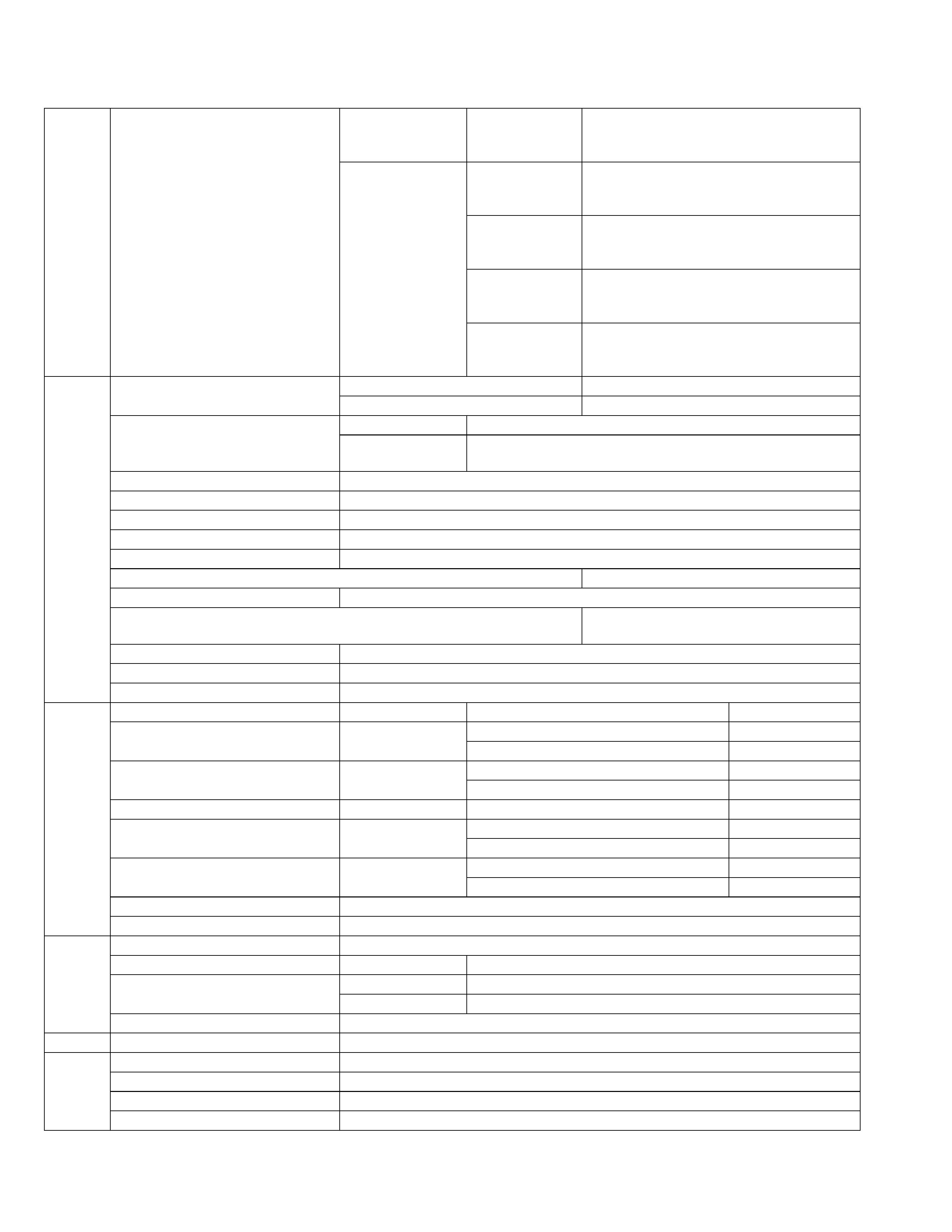
1-2 (No.22058)
SPECIFICATION
* Corresponding to Linear PCM, Dolby Digital, and DTS Digital Surround (with sampling frequency - 32 kHz, 44.1 kHz, 48 kHz).
Designs & specifications are subject to change without notice
Amplifier Output Power
At Stereo operation Front ch
110 W per channel, min. RMS, driven into
8
, 20 Hz to 20 kHz, with no more than
0.08% total harmonic distortion.
At Surround
operation
Front ch
110 W per channel, min. RMS, driven into 8
at 1 kHz, with no more than 0.8% total
harmonic distortion.
Center ch
110 W, min. RMS, driven into 8
at 1 kHz,
with no more than 0.8% total harmonic
distortion.
Surround ch
110 W per channel, min. RMS, driven into 8
at 1 kHz, with no more than 0.8% total
harmonic distortion.
Surround Back ch
110 W, min. RMS, driven into 8
at 1 kHz,
with no more than 0.8% total harmonic
distortion.
Audio
Audio Input Sensitivity/Impedance (1
kHz)
DVD IN, VCR IN, TV SOUND/DBS IN 200 mV/47 k
CD IN, TAPE/CDR IN
200 mV/47 k
Audio Input
(DIGITAL IN)*
Coaxial
DIGITAL 1 (DVD) : 0.5 V(p-p)/75
Optical
DIGITAL 2 (CD), DIGITAL 3 (TV), DIGITAL 4 (CDR) :
-21 dBm to -15 dBm (660 nm ±30 nm)
Audio Output Level
SUBWOOFER OUT : 1V
Recording Output Level
VCR OUT, TAPE/CDR OUT : 200 mV
Digital output
Optical : DIGITAL OUT
Signal wave length
660 nm
Output level
-21 dBm to -15 dBm
Signal-to-Noise Ratio (`66 IHF/'78 IHF) DVD IN, VCR IN, TV SOUND/DBS IN 87 dB/80 dB
CD IN TAPE/CDR IN
87 dB/80 dB
Frequency Response (8
at 1 kHz, with no more than 0.8% total harmonic
distortion.) DVD IN, VCR IN, TV SOUND/DBS IN
20 Hz to 100 kHz (+1 dB, -3 dB)
CD IN, TAPE/CDR IN
20 Hz to 100 kHz (+1 dB, -3 dB)
Equalization (5 bands)
63 Hz, 250 Hz, 1 kHz, 4 kHz, 16 kHz (±8 dB)
Bass boost
+6 dB ±1.0 dB at 100 Hz
Video
Video Input Sensitivity/Impedance
Composite video
DVD IN, VCR IN, TV SOUND/DBS IN
1 V(p-p)/75
S-video
DVD IN, VCR IN,
TV SOUND/DBS IN
(Y: luminance)
1 V(p-p)/75
(C: chrominance, burst)
0.286 V(p-p)/75
Component video
DVD IN, DBS IN
(Y: luminance)
1 V(p-p)/75
(PB/PR):
0.7 V(p-p)/75
Video Output Level
Composite video
VCR OUT, MONITOR OUT
1 V(p-p)/75
S-video
VCR OUT,
MONITOR OUT
(Y: luminance)
1 V(p-p)/75
(C: chrominance, burst)
0.286 V(p-p)/75
Component video
MONITOR OUT
(Y: luminance)
1 V(p-p)/75
(PB/PR)
0.7 V(p-p)/75
Synchronization
Negative
Signal-to-Noise Ratio
45 dB
FM tuner
(IHF)
Tuning Range
87.5 MHz to 108.0 MHz
Usable Sensitivity
Monaural
12.8 dBf (1.2
µV/75)
50 dB Quieting Sensitivity
Monaural
16.0 dBf (1.7
µV/75)
Stereo
37.5 dBf (20.5
µV/75)
Stereo Separation at REC OUT
35 dB at 1 kHz
AM tuner Tuning Range
530 kHz to 1 710 kHz
General
Power Requirements
AC 120V ~ 60 Hz
Power Consumption
320 W/440 VA (at operation) 2 W (in standby mode)
Dimensions (W x H x D)
435 mm x 157 mm x 425 mm (17 3/16 in. x 6 3/16 in. x 16 3/4 in.)
Mass
12.1 kg (26.7 lbs)
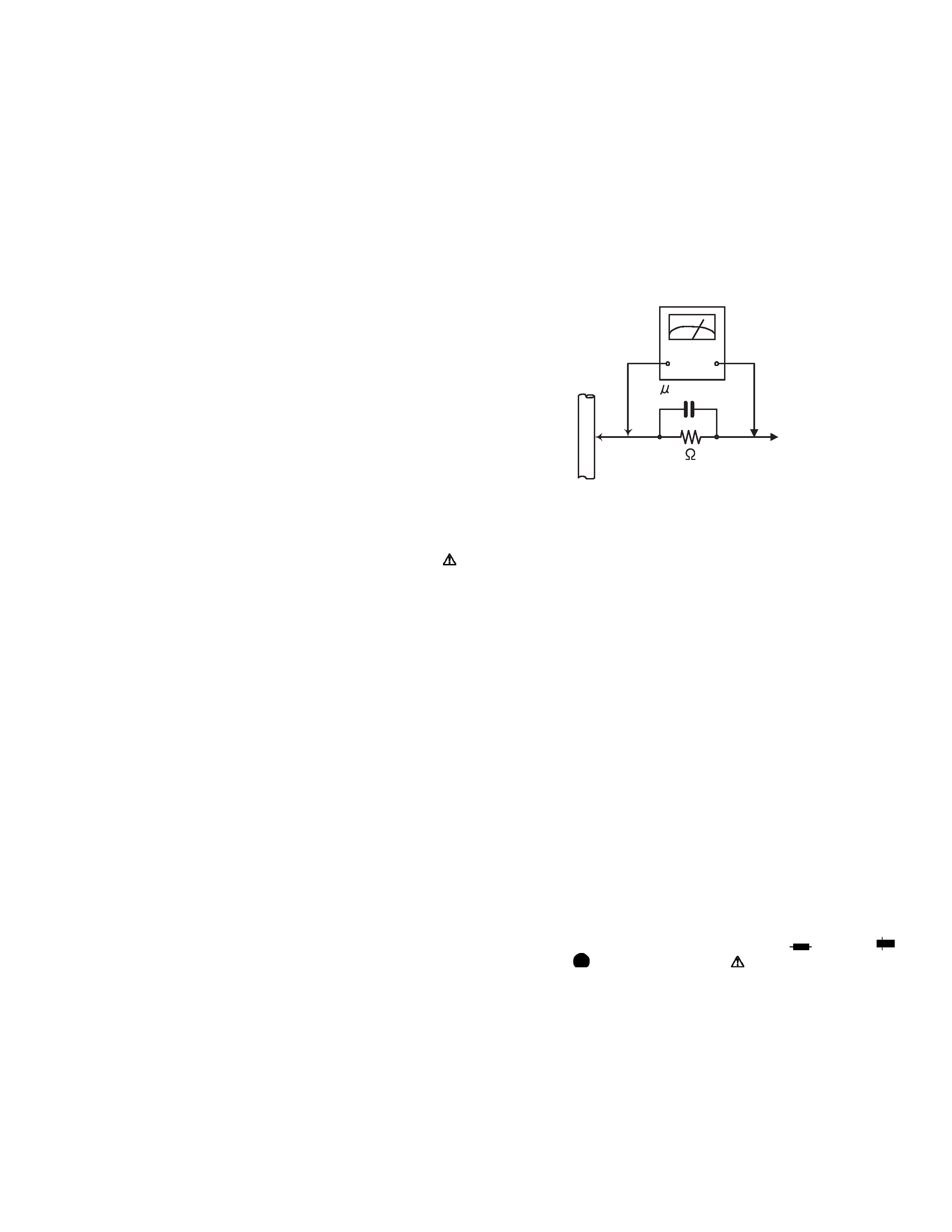
(No.22058)1-3
SECTION 1
Precautions
1.1
Safety Precautions
(1) This design of this product contains special hardware and
many circuits and components specially for safety purpos-
es. For continued protection, no changes should be made
to the original design unless authorized in writing by the
manufacturer. Replacement parts must be identical to
those used in the original circuits. Services should be per-
formed by qualified personnel only.
(2) Alterations of the design or circuitry of the product should
not be made. Any design alterations of the product should
not be made. Any design alterations or additions will void
the manufacturers warranty and will further relieve the
manufacture of responsibility for personal injury or property
damage resulting therefrom.
(3) Many electrical and mechanical parts in the products have
special safety-related characteristics. These characteris-
tics are often not evident from visual inspection nor can the
protection afforded by them necessarily be obtained by us-
ing replacement components rated for higher voltage, watt-
age, etc. Replacement parts which
have these special
safety characteristics are identified in the Parts List of Ser-
vice Manual. Electrical components having such features
are identified by shading on the schematics and by (
) on
the Parts List in the Service Manual. The use of a substitute
replacement which does not have the same safety charac-
teristics as the recommended replacement parts shown in
the Parts List of Service Manual may create shock, fire, or
other hazards.
(4) The leads in the products are routed and dressed with ties,
clamps, tubings, barriers and the like to be separated from
live parts, high temperature parts, moving parts and/or
sharp edges for the prevention of electric shock and fire
hazard. When service is required, the original lead routing
and dress should be observed, and it should be confirmed
that they have been returned to normal, after reassem-
bling.
(5) Leakage shock hazard testing
After reassembling the product, always perform an isola-
tion check on the exposed metal parts of the product (an-
tenna terminals, knobs, metal cabinet, screw heads,
headphone jack, control shafts, etc.) to be sure the product
is safe to operate without danger of electrical shock.Do not
use a line isolation transformer during this check.
· Plug the AC line cord directly into the AC outlet. Using a
"Leakage Current Tester", measure the leakage current
from each exposed metal parts of the cabinet, particular-
ly any exposed metal part having a return path to the
chassis, to a known good earth ground. Any leakage cur-
rent must not exceed 0.5mA AC (r.m.s.).
· Alternate check method
Plug the AC line cord directly into the AC outlet. Use an
AC voltmeter having, 1,000
per volt or more sensitivity
in the following manner. Connect a 1,500
10W resistor
paralleled by a 0.15
µF AC-type capacitor between an ex-
posed metal part and a known good earth ground.
Measure the AC voltage across the resistor with the AC
voltmeter.
Move the resistor connection to each exposed metal
part, particularly any exposed metal part having a return
path to the chassis, and measure the AC voltage across
the resistor. Now, reverse the plug in the AC outlet and
repeat each measurement. Voltage measured any must
not exceed 0.75 V AC (r.m.s.). This corresponds to 0.5
µ
mA AC (r.m.s.).
1.2
Warning
(1) This equipment has been designed and manufactured to
meet international safety standards.
(2) It is the legal responsibility of the repairer to ensure that
these safety standards are maintained.
(3) Repairs must be made in accordance with the relevant
safety standards.
(4) It is essential that safety critical components are replaced
by approved parts.
(5) If mains voltage selector is provided, check setting for local
voltage.
1.3
Caution
Burrs formed during molding may be left over on some parts
of the chassis.
Therefore, pay attention to such burrs in the case of pre-
forming repair of this system.
1.4
Critical parts for safety
In regard with component parts appearing on the silk-screen
printed side (parts side) of the PWB diagrams, the parts that are
printed over with black such as the resistor (
), diode (
)
and ICP (
) or identified by the "
" mark nearby are critical
for safety. When replacing them, be sure to use the parts of the
same type and rating as specified by the manufacturer.
(This regulation dose not Except the J and C version)
Good earth ground
Place this
probe on
each exposed
metal part.
AC VOLTMETER
(Having 1000
ohms/volts,
or more sensitivity)
1500
10W
0.15 F AC TYPE
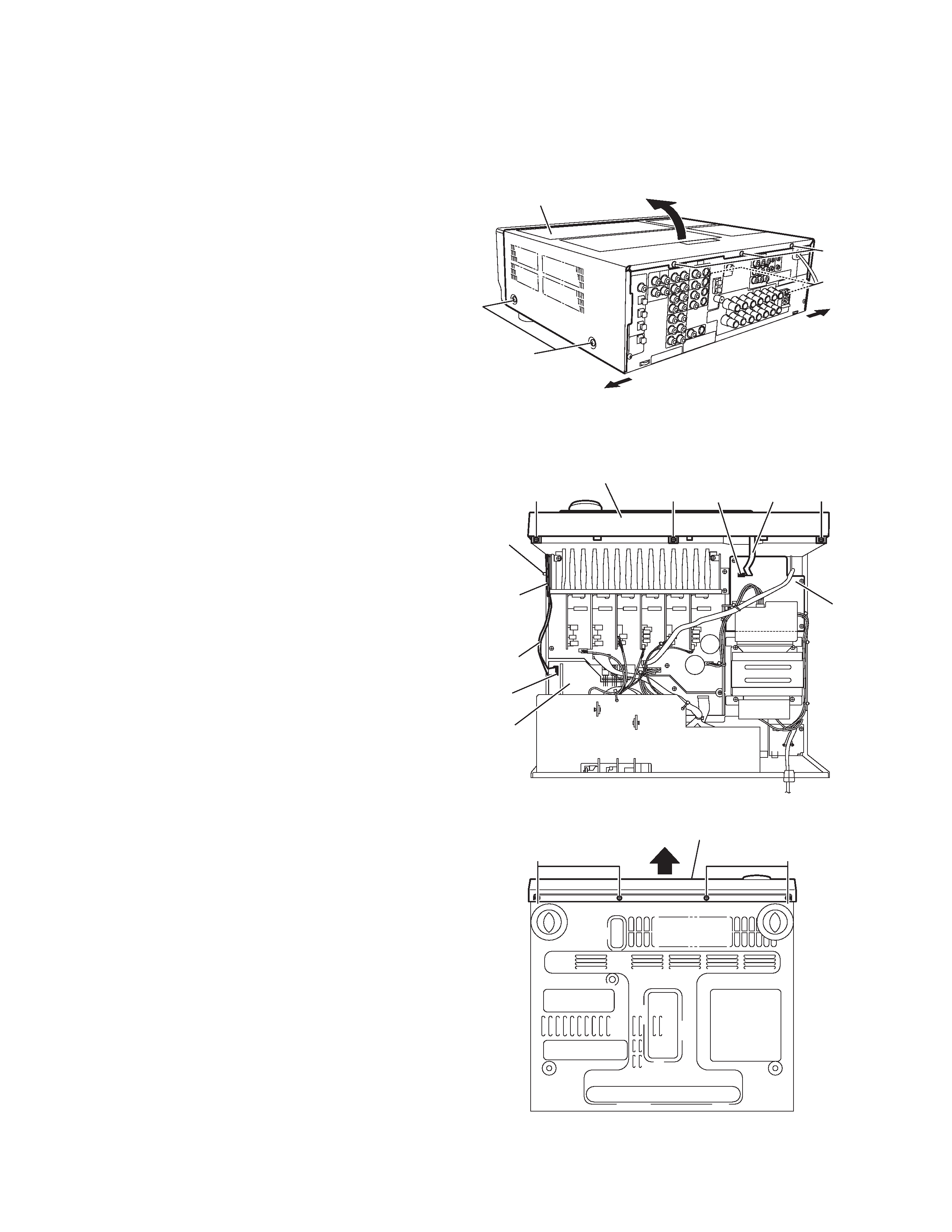
1-4 (No.22058)
SECTION 2
Disassembly method
2.1
Removing the top cover
(See Fig.1)
(1) From the right and left sides of the main body, remove the
four screws A attaching the top cover.
(2) From the back side of the main body, remove the three
screws B attaching the top cover.
(3) Remove the top cover in the direction of the arrow 2 while
extending the lower sections of the top cover in the direc-
tion of the arrow 1.
Fig.1
2.2
Removing the front panel assembly
(See Figs.2 and 3)
· Prior to performing the following procedures, remove the top
cover.
(1) Disconnect the card wire from the connector CN400 on the
micon board. (See Fig.2.)
(2) Disconnect the card wire from the connector CN402 on the
power supply board. (See Fig.2.)
(3) Remove the tie band and wire protection board fixing the
card wire. (See Fig.2.)
(4) Remove the three screws C attaching the front panel as-
sembly. (See Fig.2.)
(5) From the bottom side of the main body, remove the four
screws D attaching the front panel assembly. (See Fig.3.)
(6) Remove the front panel assembly in the direction of the ar-
row. (See Fig.3.)
Fig.2
Fig.3
Top cover
A
2
1
1
B
A
C
C
C
Front panel assembly
Card wire
CN402
Tie band
Wire
protection
board
CN400
Micon
board
Power
supply
board
Card
wire
DD
Front panel assembly
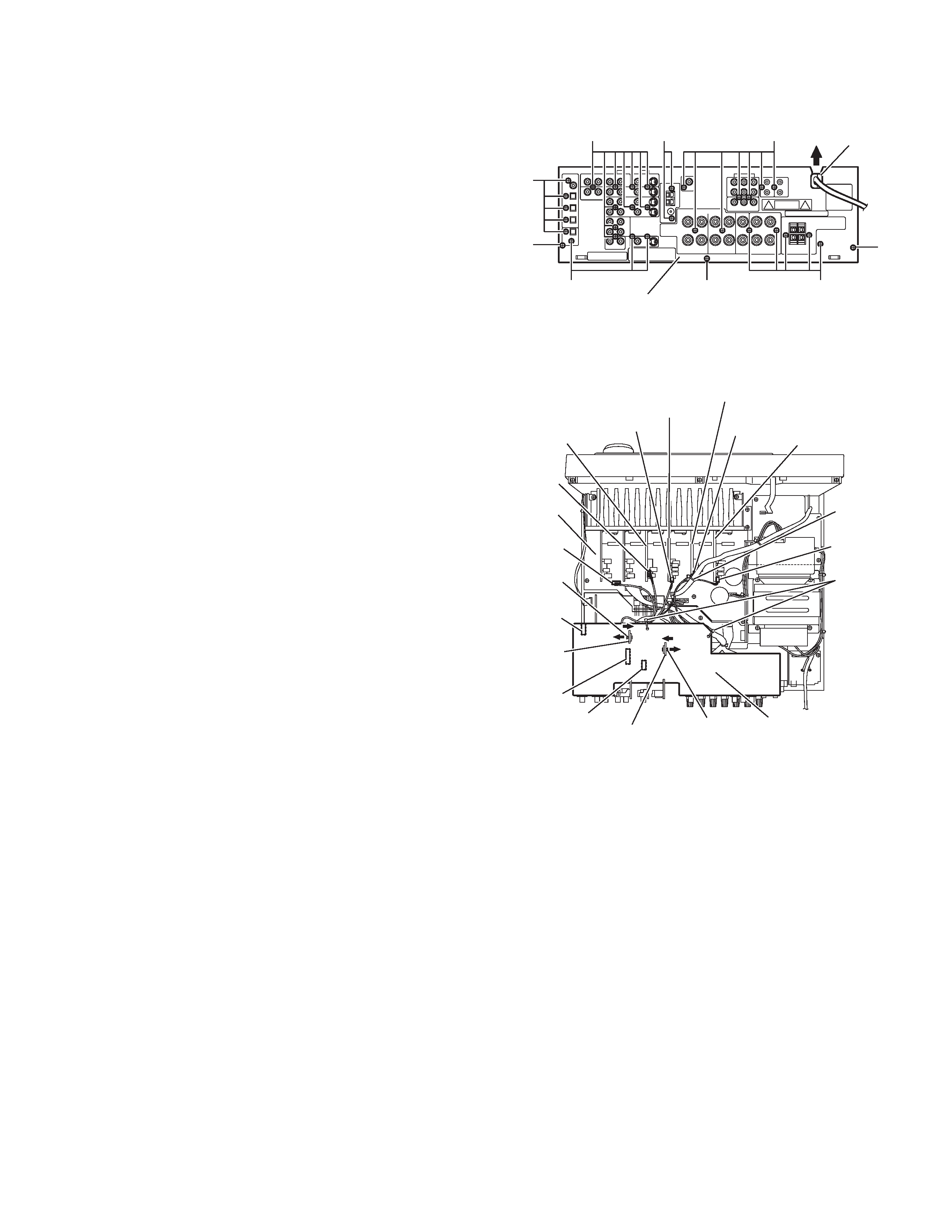
(No.22058)1-5
2.3
Removing the rear panel
(See Fig.4)
· Prior to performing the following procedures, remove the top
cover.
(1) From the back side of the main body, remove the strain re-
lief from the rear panel in the direction of the arrow.
(2) Remove the twenty-nine screws E, two screws F and three
screws G attaching the rear panel.
Fig.4
2.4
Removing the I/O board
(See Fig.5)
· Prior to performing the following procedures, remove the top
cover and rear panel.
(1) Remove the two plastic rivets in the direction of the arrow
1 from the top side of the main body, remove the stopper
boards in the direction of the arrow 2.
(2) Remove the tie bands bundling the wires.
(3) Disconnect the wire from the connector CN722 on the cen-
ter board.
(4) Disconnect the wire from the connector CN714 on the front
board(L).
(5) Disconnect the wire from the connector CN717 on the sur-
round back board.
(6) Disconnect the wire from the connector CN719 on the front
board(R).
(7) Disconnect the wire from the connector CN723 on the main
board.
(8) Disconnect the connectors (CN205,CN381,CN501) on the
I/O board in an upward direction.
Fig.5
Strain relief
E
G
E
F
G
E
E
E
G
Rear panel
1
1
1
2
2
1
1
2
2
CN381
CN205
CN501
Plastic rivet
Plastic
rivet
Stopper
board
Stopper board
Tie band
Center board
Tie bands
Front board(L)
Surround board
Front board(R)
CN719
CN717
CN714
CN722
CN723
Main
board
I/O board
